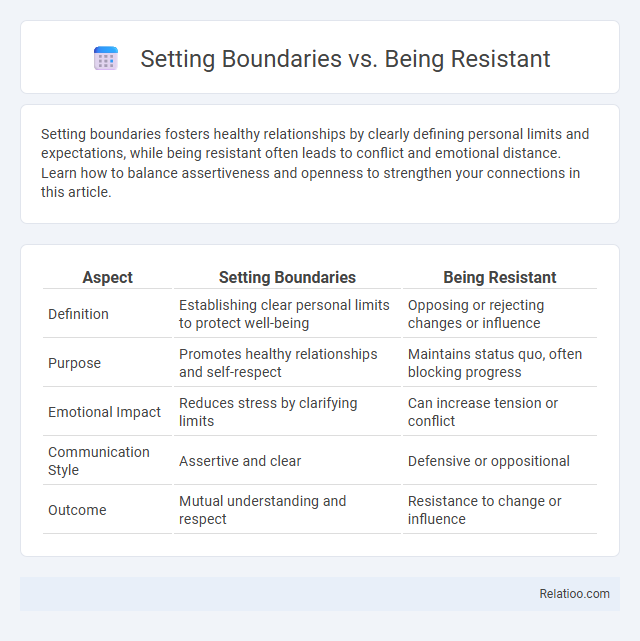Setting boundaries fosters healthy relationships by clearly defining personal limits and expectations, while being resistant often leads to conflict and emotional distance. Learn how to balance assertiveness and openness to strengthen your connections in this article.
Table of Comparison
| Aspect | Setting Boundaries | Being Resistant |
|---|---|---|
| Definition | Establishing clear personal limits to protect well-being | Opposing or rejecting changes or influence |
| Purpose | Promotes healthy relationships and self-respect | Maintains status quo, often blocking progress |
| Emotional Impact | Reduces stress by clarifying limits | Can increase tension or conflict |
| Communication Style | Assertive and clear | Defensive or oppositional |
| Outcome | Mutual understanding and respect | Resistance to change or influence |
Understanding Boundaries and Resistance
Understanding boundaries involves recognizing your limits and communicating them clearly to protect your well-being, while resistance often appears as an instinctive reaction to change or control. Setting boundaries requires deliberate intention to assert your needs without hostility, contrasting with resistance, which can manifest as opposition or defense against perceived threats. Your awareness of these distinctions helps maintain healthy relationships and promotes personal growth.
The Psychological Roots of Boundary-Setting
Setting boundaries originates from the psychological need for self-preservation and emotional regulation, serving as a clear framework that defines acceptable behavior and personal limits. Resistance often arises as a defense mechanism against perceived threats to autonomy or self-identity, rooted in unconscious fears and past traumas. Unlike mere resistance, healthy boundary-setting empowers individuals to assert control over their interactions, promoting psychological well-being and reinforcing a stable sense of self.
Signs You’re Setting Healthy Boundaries
Signs you're setting healthy boundaries include clear communication of your limits without guilt, consistent enforcement of those limits, and feeling empowered rather than anxious when saying no. Healthy boundaries promote mutual respect in relationships, while resistance often manifests as defensiveness or passive aggression when limits are challenged. Recognizing these signs helps differentiate boundary-setting from merely being resistant, facilitating emotional well-being and balanced interpersonal dynamics.
When Resistance Becomes a Barrier
Setting boundaries protects Your personal space and values, ensuring healthy relationships and self-respect. Being resistant can indicate cautiousness or a need for change, but when resistance becomes a barrier, it restricts growth, communication, and collaboration. Recognizing when resistance hinders progress is crucial to overcoming obstacles and fostering positive interactions.
Emotional Impacts of Weak vs. Rigid Boundaries
Weak boundaries can lead to emotional exhaustion and feelings of resentment as your needs are often overlooked, causing stress and decreased self-worth. Rigid boundaries may protect your well-being but can also result in isolation and difficulty forming close relationships, leading to loneliness and emotional detachment. Balancing boundary-setting with flexibility helps maintain emotional health by fostering respect while allowing connection.
Communicating Boundaries Effectively
Communicating boundaries effectively requires clear, assertive language that conveys personal limits without hostility, ensuring mutual respect in relationships. Setting boundaries involves expressing needs explicitly to prevent misunderstandings, while being resistant often implies emotional pushback or defensiveness that can hinder constructive dialogue. Mastering boundary communication enhances interpersonal dynamics by promoting clarity, reducing conflicts, and fostering healthy interactions.
Overcoming the Fear of Being Perceived as Resistant
Setting boundaries involves clearly communicating your needs and limits to promote mutual respect, while being resistant often reflects a defensive reaction to change or pressure. Resistance, in a psychological context, can stem from fear of confrontation or the discomfort of asserting oneself. Overcoming the fear of being perceived as resistant requires embracing vulnerability, developing assertiveness skills, and recognizing that healthy boundaries foster stronger relationships and personal well-being.
Differences Between Assertiveness and Defensiveness
Setting boundaries involves clear, respectful communication to protect personal limits, while being resistant reflects reluctance or opposition often rooted in discomfort or fear of change. Assertiveness promotes expressing needs confidently without infringing on others, whereas defensiveness arises from perceiving threats, leading to protective or hostile reactions. Understanding these distinctions is crucial for fostering healthy interpersonal dynamics and emotional resilience.
Practical Tips for Balancing Boundaries and Openness
Setting boundaries involves clearly defining your personal limits to protect your well-being, while being resistant often implies a defensive posture against change or input. Practical tips for balancing boundaries and openness include communicating your limits assertively yet respectfully, being willing to listen and adapt when appropriate, and regularly reassessing your boundaries to ensure they support growth without shutting down important connections. You can maintain healthy relationships by blending firm boundaries with openness to new perspectives and experiences.
Transforming Resistance into Positive Growth
Setting boundaries establishes clear limits that protect personal well-being and foster respectful interactions, while resistance often manifests as opposition to change or external pressures. Transforming resistance into positive growth involves recognizing underlying fears or concerns and channeling that energy toward self-awareness, learning, and adaptive strategies. This process enhances emotional intelligence and resilience, enabling constructive change and personal development.

Infographic: Setting Boundaries vs Being Resistant
 relatioo.com
relatioo.com